
|
Great comet. It approached to Sun down to 0.29 a.u. on July 3, and it brightened up to 0.6 mag (Alan Hale). Now it is fading. But it is still bright as 7.7 mag (Aug. 20, Osamu Miyazaki). It stays observable in the evening sky until early October when it fades down to 12 mag.
Date(TT) R.A. (2000) Decl. Delta r Elong. m1 Best Time(A, h)
Aug. 22 14 4.99 2 34.3 1.394 1.250 60 8.3 18:58 (123, 34)
Aug. 29 14 19.27 -1 34.7 1.618 1.381 57 9.1 19:03 (115, 34)
|
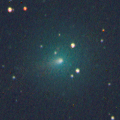
|
Now it is 9.3 mag (Aug. 19, Katsumi Yoshimoto). It stays bright as 8-9 mag until autumn. It will be observable in excellent condition in the Southern Hemisphere. It locates very low in the Northern Hemisphere.
Date(TT) R.A. (2000) Decl. Delta r Elong. m1 Best Time(A, h)
Aug. 22 14 35.39 -17 34.7 1.322 1.409 72 9.4 18:58 (109, 53)
Aug. 29 14 55.06 -19 21.0 1.335 1.390 71 9.3 19:03 (103, 52)
|

|
Now it is 10.9 mag (Aug. 15, Carlos Labordena). It stays observable in the evening sky until September when it fades down to 12 mag.
Date(TT) R.A. (2000) Decl. Delta r Elong. m1 Best Time(A, h)
Aug. 22 13 58.36 8 3.2 2.527 2.160 57 10.6 18:58 (125, 29)
Aug. 29 14 8.37 4 48.2 2.653 2.219 54 10.8 19:03 (118, 28)
|

|
Now it is 14.2 mag (Aug. 18, Alan Hale). Small comet. But it approaches to Sun down to 0.47 a.u. in September, and it was expected to brighten up to 11 mag. But actually, it is much fainter than this ephemeris recently. It will be unobservable soon.
Date(TT) R.A. (2000) Decl. Delta r Elong. m1 Best Time(A, h)
Aug. 22 6 54.36 18 34.4 0.634 0.735 46 11.7 5:07 (234, 14)
Aug. 29 7 57.32 10 58.5 0.727 0.622 37 11.2 4:59 (247, 12)
|
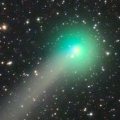
|
It brightened up to 6.0 mag in June (June 13, Marco Goiato). Now it is fading. It has already faded down to 10.6 mag (Aug. 19, Osamu Miyazaki). It stays observable in good condition for a long time after this.
Date(TT) R.A. (2000) Decl. Delta r Elong. m1 Best Time(A, h)
Aug. 22 14 41.33 21 34.3 1.492 1.430 66 11.7 18:58 (144, 24)
Aug. 29 15 2.10 22 12.2 1.612 1.516 66 12.3 19:03 (142, 23)
|

|
Now it is 10.9 mag (Aug. 8, Marco Goiato). In the Southern Hemisphere, it stays observable in good condition in the evening sky while the comet will be fading. It locates very low in the Northern Hemisphere.
Date(TT) R.A. (2000) Decl. Delta r Elong. m1 Best Time(A, h)
Aug. 22 15 3.62 -30 40.3 0.837 1.234 83 13.3 18:58 ( 92, 65)
Aug. 29 15 45.66 -31 37.3 0.958 1.337 85 14.2 19:03 ( 91, 68)
|

|
Outburst occured on July 27. It is bright as 13.6 mag still now (Aug. 20, Sandor Szabo).
Date(TT) R.A. (2000) Decl. Delta r Elong. m1 Best Time(A, h)
Aug. 22 2 52.62 26 45.8 5.553 5.819 100 13.5 4:51 (180, 28)
Aug. 29 2 53.26 27 0.7 5.449 5.821 106 13.4 4:24 (180, 28)
|
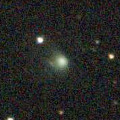
|
Now it is 14.0 mag (Aug. 20, Sandor Szabo). It is expected to brighten up to 12 mag from autumn to winter. It will be unobservable soon also in the Northern Hemisphere. In the Southern Hemisphere, it will appear in the morning sky in December, then it stays observable in good condition. In the Northern Hemisphere, it will be observable in the extremely low sky only from November to December.
Date(TT) R.A. (2000) Decl. Delta r Elong. m1 Best Time(A, h)
Aug. 22 12 24.05 29 13.4 2.875 2.151 36 13.6 18:58 (125, -1)
Aug. 29 12 29.65 25 44.0 2.878 2.099 32 13.5 19:03 (118, -4)
|
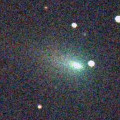
|
Recovered from SWAN images after 24-year blank. It brightened up to 10.2 mag in spring (May 31, Marco Goiato). Now it is fading. It has already faded down to 15.2 mag (Aug. 21, Sandor Szabo). It stays observable for a long time after this until the comet fades out.
Date(TT) R.A. (2000) Decl. Delta r Elong. m1 Best Time(A, h)
Aug. 22 5 58.24 12 18.0 1.963 1.703 60 13.6 5:07 (228, 28)
Aug. 29 6 12.94 11 47.4 1.954 1.749 63 13.8 4:59 (228, 29)
|
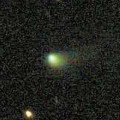
|
Now it is 14.2 mag (July 16, Paul Camilleri). It stays 13-14 mag from 2020 to 2021. It will be unobservable in September.
Date(TT) R.A. (2000) Decl. Delta r Elong. m1 Best Time(A, h)
Aug. 22 13 27.63 1 2.9 3.556 3.030 51 14.4 18:58 (114, 29)
Aug. 29 13 35.91 -0 14.6 3.613 3.018 47 14.4 19:03 (108, 25)
|

|
Now it is 14.0 mag (Aug. 15, Toshihiko Ikemura, Hirohisa Sato). It stays 14 mag until autumn. In the Southern Hemisphere, it will never be observable again.
Date(TT) R.A. (2000) Decl. Delta r Elong. m1 Best Time(A, h)
Aug. 22 12 54.29 78 48.8 4.363 4.129 70 14.5 18:58 (169,-29)
Aug. 29 13 17.84 76 50.3 4.389 4.171 70 14.5 19:03 (166,-28)
|

|
It was expected to brighten very rapidly, and brighten up to 14.5 mag from August to September. However, its current brightness is very uncertain. It could not be detected as fainter than 18.0 mag on June 30 (Charles S. Morris), and fainter than 15.7 mag on July 13 (Sandor Szabo). However, Giuseppe Pappa reported as 14 mag on July 10, and Thomas Lehmann reported it is bright as 15.2 mag on July 12. In the Northern Hemisphere, it stays observable for a long time, although it becomes extremely low in early September. In the Southern Hemisphere, it is not observable until late October.
Date(TT) R.A. (2000) Decl. Delta r Elong. m1 Best Time(A, h)
Aug. 22 10 38.79 48 18.7 1.529 0.947 37 14.7 18:58 (130,-29)
Aug. 29 10 41.61 42 34.4 1.601 0.939 33 14.7 19:03 (122,-32)
|
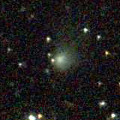
|
Now it is 15.0 mag (Aug. 14, Toshihiko Ikemura, Hirohisa Sato). It is expected to be observable at 5-6 mag for a long time from 2022 to 2023. In the Northern Hemisphere, it is not observable at the high light from 2022 summer to 2023 summer. In the Southern Hemisphere, it is only visible in the extremely low sky in summer in 2020. But it will be observable in good condition at the high light.
Date(TT) R.A. (2000) Decl. Delta r Elong. m1 Best Time(A, h)
Aug. 22 17 6.33 48 1.0 8.359 8.441 91 14.9 19:02 (180, 7)
Aug. 29 17 5.07 47 6.3 8.347 8.389 88 14.8 19:03 (175, 8)
|
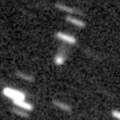
|
Now it is 15.4 mag (July 9, R. Carstens). It will brighten up to 13 mag in 2021. In the Southern Hemisphere, it stays observable at 15 mag until October. In the Northern Hemisphere, it is not observable until July in 2022.
Date(TT) R.A. (2000) Decl. Delta r Elong. m1 Best Time(A, h)
Aug. 22 13 58.89 -26 33.9 4.774 4.504 68 14.9 18:58 ( 89, 50)
Aug. 29 14 2.46 -27 17.4 4.834 4.468 63 14.9 19:03 ( 84, 45)
|

|
Bright new comet. Now it is 15.5 mag (Aug. 21, Sandor Szabo). It approaches to Earth down to 0.7 a.u. in September, and it will brighten up to 14 mag. It stays observable in excellent condition in the Northern Hemipshere. In the Southern Hemipshere, it is not obserbvable at the high light.
Date(TT) R.A. (2000) Decl. Delta r Elong. m1 Best Time(A, h)
Aug. 22 5 31.43 32 53.2 1.364 1.319 65 15.4 5:07 (210, 14)
Aug. 29 5 21.36 38 31.0 1.183 1.331 74 15.1 4:59 (202, 12)
|
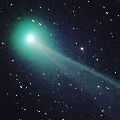
|
It brightened up to 4.7 mag in early May (May 2, Marco Goiato). However, it has faded and got diffused after that. It had already faded down to 7.3 mag in late May (May 21, Mitsunori Tsumura). It is appearing in the morning sky. However, maybe it has already disappeared. It stays observable in good condition after this.
Date(TT) R.A. (2000) Decl. Delta r Elong. m1 Best Time(A, h)
Aug. 22 6 46.18 15 44.3 2.326 1.818 48 15.1 5:07 (235, 18)
Aug. 29 6 46.82 13 51.7 2.323 1.927 54 15.4 4:59 (233, 22)
|

|
Now it is 15.1 mag (July 26, J. Drummond). It stays 14-15 mag until 2021. In the Southern Hemisphere, it stays observable in good condition for a long time. In the Northern Hemisphere, it is not observable until June in 2021.
Date(TT) R.A. (2000) Decl. Delta r Elong. m1 Best Time(A, h)
Aug. 22 15 36.18 -77 14.1 4.390 4.671 99 15.2 18:58 ( 7, 47)
Aug. 29 15 52.65 -76 22.2 4.420 4.650 96 15.2 19:03 ( 8, 47)
|

|
New comet. Now it is 15.5 mag (Aug. 4, M. Mattiazzo). Although it is a tiny comet, it will approach to Sun down to 0.34 a.u. on Oct. 20, and it is expected to brighten up to 8.5 mag. In the Southern Hemisphere, it stays observable in good condition until late September when it brightens up to 11.5 mag. In the Northern Hemisphere, it stays unobservable for a while. But it will appear in the morning sky at 10 mag in late October. Then it stasy observable while the comet will be fading rapidly.
Date(TT) R.A. (2000) Decl. Delta r Elong. m1 Best Time(A, h)
Aug. 22 12 24.94 -66 42.6 1.118 1.408 82 15.7 18:58 ( 29, 40)
Aug. 29 12 24.79 -63 18.9 1.071 1.281 75 15.2 19:03 ( 33, 36)
|

|
Now it is 15.5 mag (July 18, P. Camilleri, H. Williams, J. Oey, M. Al-Bussadi). It will brighten up to 13.5 mag in spring in 2021. In the Southern Hemisphere, it stays observable in good condition for a long time. In the Northern Hemisphere, it is not observable until spring in 2021.
Date(TT) R.A. (2000) Decl. Delta r Elong. m1 Best Time(A, h)
Aug. 22 18 19.53 -63 36.2 3.484 4.019 115 15.3 20:15 ( 0, 62)
Aug. 29 18 0.37 -62 1.5 3.545 3.985 108 15.3 19:28 ( 0, 63)
|

|
Now it is 14.9 mag (Aug. 15, Toshihiko Ikemura, Hirohisa Sato). It will brighten up to 12 mag in winter in 2022. In the Northern Hemisphere, it stays observable in good condition for a long time. In the Southern Hemisphere, it is not observable until 2021 November.
Date(TT) R.A. (2000) Decl. Delta r Elong. m1 Best Time(A, h)
Aug. 22 0 54.75 63 0.8 5.413 5.649 98 15.4 2:54 (180, -8)
Aug. 29 0 52.44 63 46.9 5.307 5.606 102 15.3 2:24 (180, -9)
|

|
It brightened up to 13.5 mag in winter (Dec. 6, Chris Wyatt). Now it is fading slowly. Now it is 15.1 mag (July 25, ATLAS-MLO, Mauna Loa). In the Southern Hemisphere, it stays observable for a long time. In the Northern Hemisphere, it is appearing in the morning sky, but it stays low for a while.
Date(TT) R.A. (2000) Decl. Delta r Elong. m1 Best Time(A, h)
Aug. 22 3 18.36 -36 26.6 3.789 4.187 106 15.5 5:07 (306, 88)
Aug. 29 3 14.00 -36 52.6 3.756 4.222 110 15.5 4:44 ( 0, 88)
|

|
Now it is 15.5 mag (Aug. 14, Toshihiko Ikemura, Hirohisa Sato). It stays 15-16 mag for a long time until 2021.
Date(TT) R.A. (2000) Decl. Delta r Elong. m1 Best Time(A, h)
Aug. 22 18 53.75 20 14.3 3.874 4.507 123 15.5 20:49 (180, 35)
Aug. 29 18 46.74 20 13.1 3.958 4.514 117 15.5 20:14 (180, 35)
|

|
Now it is 15.5 mag (Aug. 18, Giuseppe Pappa). It stays 15.5 mag from summer to winter, and observable in good condition. It locates somewhat low in the Southern Hemisphere.
Date(TT) R.A. (2000) Decl. Delta r Elong. m1 Best Time(A, h)
Aug. 22 6 25.28 19 30.4 2.291 1.869 53 15.6 5:07 (229, 18)
Aug. 29 6 41.15 19 28.0 2.261 1.895 56 15.5 4:59 (228, 19)
|
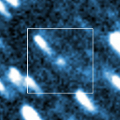
|
Now it is 15.9 mag (Aug. 11, Toshihiko Ikemura, Hirohisa Sato). It stays observable until December when it becomes fainter than 18 mag.
Date(TT) R.A. (2000) Decl. Delta r Elong. m1 Best Time(A, h)
Aug. 22 19 11.03 -7 5.1 1.209 2.067 136 15.6 21:07 (180, 62)
Aug. 29 19 14.26 -8 14.3 1.261 2.073 131 15.8 20:43 (180, 63)
|

|
Now it is 17.0 mag (July 29, ATLAS-MLO, Mauna Loa). It will brighten up to 14 mag in November, and will be observable in excellent condition.
Date(TT) R.A. (2000) Decl. Delta r Elong. m1 Best Time(A, h)
Aug. 22 2 30.64 -36 8.5 0.850 1.580 115 16.1 4:28 ( 0, 89)
Aug. 29 2 50.97 -36 24.3 0.786 1.523 115 15.8 4:21 ( 0, 89)
|
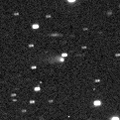
|
Now it is 15.6 mag (July 25, ATLAS-MLO, Mauna Loa). It is observable at 15-16 mag in 2020. It is observable in excellent condition in the Southern Hemisphere. It locates somewhat low in the Northern Hemisphere.
Date(TT) R.A. (2000) Decl. Delta r Elong. m1 Best Time(A, h)
Aug. 22 18 16.18 -27 4.4 6.204 6.827 124 15.9 20:12 (180, 82)
Aug. 29 18 11.75 -26 41.2 6.329 6.844 116 15.9 19:40 (180, 82)
|
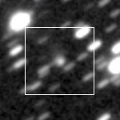
|
Now it is 15.3 mag (Aug. 20, Sandor Szabo). It will stay at 15 mag for a long time from 2021 to 2022. In the Northern Hemisphere, it stays observable in good condition while brightening gradually. In the Southern Hemisphere, it stays locating low for a long time.
Date(TT) R.A. (2000) Decl. Delta r Elong. m1 Best Time(A, h)
Aug. 22 17 36.34 24 57.0 5.652 5.994 104 16.0 19:32 (180, 30)
Aug. 29 17 33.27 23 32.8 5.701 5.966 100 16.0 19:03 (180, 32)
|

|
Now it is 16.8 mag (July 2, R. Carstens). It brightens up to 16 mag from summer to winter. In the Southern Hemisphere, it is observable in excellent condition. In the Northern Hemisphere, it is not observable until late October.
Date(TT) R.A. (2000) Decl. Delta r Elong. m1 Best Time(A, h)
Aug. 22 21 31.47 -70 41.8 0.999 1.748 120 16.2 23:26 ( 0, 54)
Aug. 29 21 13.73 -70 2.6 0.974 1.702 118 16.1 22:41 ( 0, 55)
|
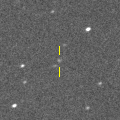
|
Now it is 16.0 mag (Aug. 20, Sandor Szabo). It will brighten up to 14.5 mag from spring to summer in 2021. In the Southern Hemisphere, it stays observable in excellent condition for a long time. In the Northern Hemisphere, it is observable in good condition in 2020, however, it will be unobservable in 2021.
Date(TT) R.A. (2000) Decl. Delta r Elong. m1 Best Time(A, h)
Aug. 22 22 39.07 -3 41.8 2.638 3.634 168 16.3 0:38 (180, 58)
Aug. 29 22 29.44 -6 18.3 2.579 3.588 176 16.2 0:01 (180, 61)
|
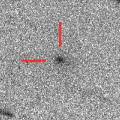
|
Now it is 15.7 mag (Aug. 17, Toshihiko Ikemura, Hirohisa Sato). It stays 16 mag until late September. It is observable in good condition in the Northern Hemisphere. It locates low in the Southern Hemisphere.
Date(TT) R.A. (2000) Decl. Delta r Elong. m1 Best Time(A, h)
Aug. 22 5 48.80 22 44.5 1.377 1.264 61 16.3 5:07 (219, 21)
Aug. 29 6 14.65 22 57.9 1.373 1.274 62 16.2 4:59 (221, 20)
|

|
Now it is 16.9 mag (Aug. 13, Toshihiko Ikemura, Hirohisa Sato). It stays 16.5 mag until October, and observable in good condition.
Date(TT) R.A. (2000) Decl. Delta r Elong. m1 Best Time(A, h)
Aug. 22 20 13.33 14 35.9 1.260 2.148 141 16.3 22:08 (180, 40)
Aug. 29 20 12.31 13 13.7 1.278 2.145 138 16.3 21:40 (180, 42)
|
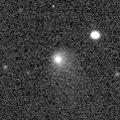
|
It brightened up to 13.8 mag in autumn in 2019 (Sept. 3, Chris Wyatt). Now it is fading slowly. Now it is 15.6 mag (Aug. 20, Sandor Szabo). In 2020, it stays observable in good condition while the comet will be fading from 16 to 17 mag.
Date(TT) R.A. (2000) Decl. Delta r Elong. m1 Best Time(A, h)
Aug. 22 0 28.35 1 22.6 5.289 6.118 142 16.4 2:27 (180, 54)
Aug. 29 0 24.77 1 30.1 5.267 6.159 149 16.4 1:56 (180, 53)
|
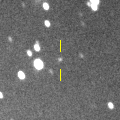
|
Now it is 15.9 mag (Apr. 24, J. Drummond). It is expected to brighten up to 13 mag in 2022. In 2020, it is observable in excellent condition in the Southern Hemisphere. In the Northern Hemisphere, it is not observable. It will be observable from autumn to winter, but it locating extremely low.
Date(TT) R.A. (2000) Decl. Delta r Elong. m1 Best Time(A, h)
Aug. 22 7 47.12 -27 16.0 7.299 6.714 51 16.6 5:07 (283, 31)
Aug. 29 7 52.39 -27 46.7 7.228 6.674 53 16.5 4:59 (282, 34)
|
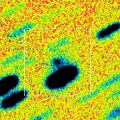
|
Now it is 16.4 mag (July 29, ATLAS-MLO, Mauna Loa). It brightens up to 15 mag in winter. But it is not observable at high light. In the Southern Hemisphere, it stays observable in good condition until autumn when the comet will brighten up to 16 mag. It stays locating very low in the Northern Hemisphere.
Date(TT) R.A. (2000) Decl. Delta r Elong. m1 Best Time(A, h)
Aug. 22 17 52.48 -39 18.7 1.844 2.487 118 16.7 19:49 ( 0, 86)
Aug. 29 17 55.03 -38 3.4 1.892 2.461 112 16.6 19:24 ( 0, 87)
|
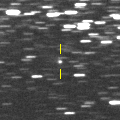
|
Now it is 16.0 mag (Aug. 20, Sandor Szabo). It is observable at 16.5-17 mag from spring in 2020 to summer in 2021.
Date(TT) R.A. (2000) Decl. Delta r Elong. m1 Best Time(A, h)
Aug. 22 17 33.60 12 19.4 4.250 4.670 108 16.7 19:29 (180, 43)
Aug. 29 17 28.43 10 43.7 4.344 4.663 102 16.7 19:03 (178, 44)
|

|
Now it is 16.8 mag (Aug. 15, Toshihiko Ikemura, Hirohisa Sato). It is observable at 16.5-17 mag from 2020 to 2021. In the Southern Hemisphere, it is not observable until summer in 2021.
Date(TT) R.A. (2000) Decl. Delta r Elong. m1 Best Time(A, h)
Aug. 22 0 58.70 74 36.7 6.023 6.099 89 16.8 2:58 (180,-20)
Aug. 29 0 39.38 74 46.0 5.941 6.088 93 16.8 2:12 (180,-20)
|
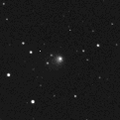
|
It brightened up to 13.2 mag from spring to autumn in 2019 (June 30, Thomas Lehmann). Now it is fading slowly. It has already faded down to 16.8 mag (July 31, ATLAS-HKO, Haleakala). In the Southern Hemisphere, it stays observable for a long time. In the Northern Hemisphere, it stays low for a long time.
Date(TT) R.A. (2000) Decl. Delta r Elong. m1 Best Time(A, h)
Aug. 22 23 19.29 -31 0.7 3.614 4.546 154 16.9 1:19 (180, 86)
Aug. 29 23 10.39 -30 51.7 3.642 4.586 156 16.9 0:42 (180, 86)
|

|
Now it is 17.9 mag (July 31, ATLAS-HKO, Haleakala). It is expected to brighten up to 16 mag from October to November, and it will be observable in excellent condition.
Date(TT) R.A. (2000) Decl. Delta r Elong. m1 Best Time(A, h)
Aug. 22 0 16.11 -37 7.3 0.747 1.661 141 17.3 2:15 ( 0, 88)
Aug. 29 0 15.41 -37 41.5 0.692 1.618 143 17.0 1:47 ( 0, 87)
|
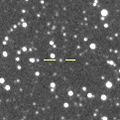
|
Now it is 16.9 mag (Aug. 11, Toshihiko Ikemura, Hirohisa Sato). It stays at 17 mag from 2020 to 2021.
Date(TT) R.A. (2000) Decl. Delta r Elong. m1 Best Time(A, h)
Aug. 22 19 7.94 32 6.3 8.359 8.894 119 17.1 21:03 (180, 23)
Aug. 29 19 4.88 31 57.1 8.402 8.889 115 17.1 20:32 (180, 23)
|

|
Now it is fainter than 16.5 mag (Aug. 18, Giuseppe Pappa). It was expected to brighten rapidly up to 9.5 mag in June. But actually, it was fainter than predicted. However, it became very bright as 7.5 mag in SOHO spacecraft images on June 19 (Karl Battams). It is observable in good condition after this while the comet will be fading.
Date(TT) R.A. (2000) Decl. Delta r Elong. m1 Best Time(A, h)
Aug. 22 6 23.11 24 29.4 1.394 1.141 53 17.1 5:07 (225, 15)
Aug. 29 6 34.22 23 51.0 1.432 1.240 58 17.8 4:59 (224, 16)
|
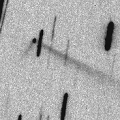
|
Now it is 17.5 mag (Aug. 15, Toshihiko Ikemura, Hirohisa Sato). Main-belt asteroid. But it showed a straight tail like a comet in 2019. In 2020, it brightens up to 16.5 mag and stays observable in good condition from September to October.
Date(TT) R.A. (2000) Decl. Delta r Elong. m1 Best Time(A, h)
Aug. 22 0 40.91 10 50.6 1.363 2.199 135 17.3 2:40 (180, 44)
Aug. 29 0 38.76 9 22.7 1.323 2.214 142 17.2 2:10 (180, 45)
|

|
First return of a new periodic comet which brightened up to 17.5 mag in 2012. Now it is 17.5 mag (Aug. 15, Toshihiko Ikemura, Hirohisa Sato). It stays observable at 17 mag in good condition from summer to winter. It locates somewhat low in the Southern Hemisphere.
Date(TT) R.A. (2000) Decl. Delta r Elong. m1 Best Time(A, h)
Aug. 22 4 24.88 28 13.9 2.272 2.323 80 17.3 5:07 (198, 24)
Aug. 29 4 35.22 29 11.5 2.204 2.333 84 17.2 4:59 (196, 24)
|
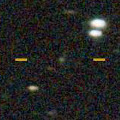
|
Now it is 17.1 mag (July 31, ATLAS-HKO, Haleakala). It became brighter than orignally predicted. It stays observable at 17 mag in good condition until autumn.
Date(TT) R.A. (2000) Decl. Delta r Elong. m1 Best Time(A, h)
Aug. 22 14 16.64 -18 45.8 2.228 2.094 69 17.4 18:58 (103, 50)
Aug. 29 14 30.23 -19 54.4 2.289 2.090 65 17.4 19:03 ( 98, 47)
|

|
It brightened up to 7.7 mag in June in 2018 (June 19, Juan Jose Gonzalez). Now it is fading. It has already faded down to 16.9 mag (Apr. 22, J. Drummond). In the Southern Hemisphere, it stays observable for a long time until the comet will fade out. It will be observable in good condition after this also in the Northern Hemisphere.
Date(TT) R.A. (2000) Decl. Delta r Elong. m1 Best Time(A, h)
Aug. 22 6 34.62 -10 27.1 7.938 7.432 56 17.4 5:07 (255, 37)
Aug. 29 6 36.43 -10 38.3 7.913 7.485 61 17.4 4:59 (252, 41)
|

|
Now it is 17.7 mag (Aug. 15, Toshihiko Ikemura, Hirohisa Sato). It stays 17.5 mag until November. It is observable in excellent condition in the Southern Hemisphere. It locates very low in the Northern Hemisphere.
Date(TT) R.A. (2000) Decl. Delta r Elong. m1 Best Time(A, h)
Aug. 22 23 27.66 -29 27.5 2.204 3.144 153 17.5 1:27 (180, 84)
Aug. 29 23 24.45 -30 58.9 2.197 3.142 155 17.5 0:56 (180, 86)
|

|
Now it is 18.7 mag (Aug. 17, Toshihiko Ikemura, Hirohisa Sato). It will brighten up to 17.5 mag in September. It is observable in excellent condition in the Southern Hemisphere. It locates somewhat low in the Northern Hemisphere.
Date(TT) R.A. (2000) Decl. Delta r Elong. m1 Best Time(A, h)
Aug. 22 23 20.07 -13 52.4 1.016 2.002 161 17.5 1:19 (180, 69)
Aug. 29 23 19.03 -16 12.9 0.999 1.995 166 17.5 0:50 (180, 71)
|

|
Now it is 17.4 mag (July 31, ATLAS-HKO, Haleakala). It will brighten up to 15.5 mag in early 2021. In 2020, it stays observable at 17 mag until November in the Southern Hemisphere. In the Northern Hemisphere, it will be unobservable soon. Then it stays unobservable until 2021 June.
Date(TT) R.A. (2000) Decl. Delta r Elong. m1 Best Time(A, h)
Aug. 22 14 25.98 -28 51.5 2.820 2.737 74 17.7 18:58 ( 89, 57)
Aug. 29 14 34.16 -29 5.1 2.851 2.681 70 17.6 19:03 ( 86, 52)
|
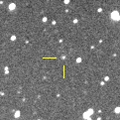
|
Now it is 17.7 mag (Aug. 15, Toshihiko Ikemura, Hirohisa Sato). It was observed at 17 mag in 2019. In 2020, it is observable at 17.5 mag in good condition from summer to autumn.
Date(TT) R.A. (2000) Decl. Delta r Elong. m1 Best Time(A, h)
Aug. 22 1 1.74 -5 27.8 2.951 3.744 135 17.7 3:00 (180, 60)
Aug. 29 0 59.73 -5 46.9 2.895 3.750 142 17.7 2:31 (180, 61)
|
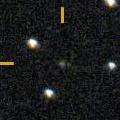
|
It is observable at 17-18 mag for a long time from late 2019 to early 2021. It will fade out before it passes the perihelion.
Date(TT) R.A. (2000) Decl. Delta r Elong. m1 Best Time(A, h)
Aug. 22 5 37.52 16 8.5 5.004 4.663 64 17.8 5:07 (221, 28)
Aug. 29 5 42.48 16 13.0 4.895 4.651 70 17.7 4:59 (218, 30)
|
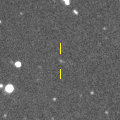
|
Now it is 17.3 mag (Aug. 13, Toshihiko Ikemura, Hirohisa Sato). It stays 18 mag from 2019 to 2020.
Date(TT) R.A. (2000) Decl. Delta r Elong. m1 Best Time(A, h)
Aug. 22 20 58.08 -6 55.0 3.619 4.595 162 17.7 22:53 (180, 62)
Aug. 29 20 55.07 -7 22.7 3.654 4.597 156 17.8 22:23 (180, 62)
|
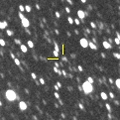
|
Sam Deen pointed out that it brightened in outburst twice in 2017 and 2019. It was observed at 20-21 mag in 2017. Then it became fainter than 22.9 mag in 2018 summer (Aug. 29, Sam Deen). However, it brightened up to 17.2 mag in 2019 spring (Mar. 25, B. T. Bolin). Then it faded again down to 19.9 mag (May 29, Toshihiko Ikemura, Hirohisa Sato). Now it is 18.1 mag (July 9, J. Jahn). It is predicted to stay observable at 18 mag for a long time from 2019 to 2021. But actually, it may be fainter than this ephemeris.
Date(TT) R.A. (2000) Decl. Delta r Elong. m1 Best Time(A, h)
Aug. 22 18 29.36 -25 5.4 7.078 7.736 127 17.8 20:25 (180, 80)
Aug. 29 18 27.45 -25 34.2 7.182 7.741 120 17.8 19:56 (180, 81)
|

|
Now it is 17.4 mag (July 26, J. Drummond). It will brighten up to 16.5 mag in 2021 summer. In the Southern Hemisphere, it stays observable for a while. In the Northern Hemisphere, it is not observable until 2021 February.
Date(TT) R.A. (2000) Decl. Delta r Elong. m1 Best Time(A, h)
Aug. 22 14 36.66 -48 35.8 5.654 5.654 84 17.8 18:58 ( 52, 60)
Aug. 29 14 41.84 -47 38.0 5.725 5.628 79 17.8 19:03 ( 55, 56)
|

|
It stays observable at 17 mag for a long time until 2027. In the Southern Hemipshere, it stays observable in good condition for a long time. It is not observable in the Northern Hemipsphere.
Date(TT) R.A. (2000) Decl. Delta r Elong. m1 Best Time(A, h)
Aug. 22 9 49.31 -43 47.2 12.592 12.051 55 17.8 5:07 (312, 17)
Aug. 29 9 51.63 -44 7.7 12.595 12.032 54 17.8 4:59 (311, 20)
|

|
First return of a new periodic comet which brightened up to 16 mag from 2003 to 2004. Now it is 19.2 mag (Aug. 19, E. Kuusela). It will brighten up to 16 mag in winter between 2021 and 2022.
Date(TT) R.A. (2000) Decl. Delta r Elong. m1 Best Time(A, h)
Aug. 22 3 7.53 -17 41.6 4.346 4.742 107 18.0 5:06 (180, 73)
Aug. 29 3 9.31 -18 22.0 4.249 4.722 112 17.9 4:40 (180, 73)
|

|
Now it is 17.7 mag (Aug. 17, Toshihiko Ikemura, Hirohisa Sato). It stays observable at 17.5-18 mag in good condition until winter.
Date(TT) R.A. (2000) Decl. Delta r Elong. m1 Best Time(A, h)
Aug. 22 5 44.96 16 22.7 2.142 1.908 62 18.0 5:07 (222, 27)
Aug. 29 6 0.24 16 37.5 2.094 1.919 65 17.9 4:59 (221, 27)
|
|
![]()
 C/2017 K2 ( PanSTARRS )
C/2017 K2 ( PanSTARRS ) C/2019 F1 ( ATLAS-Africano )
C/2019 F1 ( ATLAS-Africano ) C/2020 Q1 ( Borisov )
C/2020 Q1 ( Borisov ) C/2020 F8 ( SWAN )
C/2020 F8 ( SWAN ) C/2020 F5 ( MASTER )
C/2020 F5 ( MASTER ) C/2020 P1 ( NEOWISE )
C/2020 P1 ( NEOWISE ) C/2020 J1 ( SONEAR )
C/2020 J1 ( SONEAR ) C/2019 L3 ( ATLAS )
C/2019 L3 ( ATLAS ) C/2018 F4 ( PanSTARRS )
C/2018 F4 ( PanSTARRS ) C/2019 K7 ( Smith )
C/2019 K7 ( Smith ) 84P/Giclas
84P/Giclas 115P/Maury
115P/Maury C/2020 M3 ( ATLAS )
C/2020 M3 ( ATLAS ) C/2017 U7 ( PanSTARRS )
C/2017 U7 ( PanSTARRS ) C/2018 U1 ( Lemmon )
C/2018 U1 ( Lemmon ) 162P/Siding Spring
162P/Siding Spring C/2019 T2 ( Lemmon )
C/2019 T2 ( Lemmon ) 304P/Ory
304P/Ory 257P/Catalina
257P/Catalina C/2017 B3 ( LINEAR )
C/2017 B3 ( LINEAR ) C/2019 T4 ( ATLAS )
C/2019 T4 ( ATLAS ) 17P/Holmes
17P/Holmes C/2017 Y2 ( PanSTARRS )
C/2017 Y2 ( PanSTARRS ) C/2019 T3 ( ATLAS )
C/2019 T3 ( ATLAS ) C/2018 A6 ( Gibbs )
C/2018 A6 ( Gibbs ) 156P/Russell-LINEAR
156P/Russell-LINEAR C/2019 O3 ( Palomar )
C/2019 O3 ( Palomar ) 249P/LINEAR
249P/LINEAR (6478) Gault
(6478) Gault P/2020 M2 ( Lemmon )
P/2020 M2 ( Lemmon ) 278P/McNaught
278P/McNaught C/2016 M1 ( PanSTARRS )
C/2016 M1 ( PanSTARRS ) 254P/McNaught
254P/McNaught 312P/NEAT
312P/NEAT 28P/Neujmin 1
28P/Neujmin 1 215P/NEAT
215P/NEAT 173P/Mueller 5
173P/Mueller 5 P/2019 LD2 ( ATLAS )
P/2019 LD2 ( ATLAS ) C/2017 K5 ( PanSTARRS )
C/2017 K5 ( PanSTARRS ) C/2020 O2 ( Amaral )
C/2020 O2 ( Amaral ) C/2019 E3 ( ATLAS )
C/2019 E3 ( ATLAS ) P/2002 T5 ( LINEAR )
P/2002 T5 ( LINEAR ) 178P/Hug-Bell
178P/Hug-Bell![]()






































